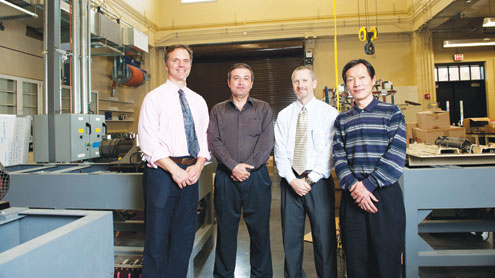New lab space devoted to electromechanical systems in the South Engineering Research Center will enable research not possible before in the College of Engineering, according to Tim Haskew, professor and interim head of the electrical and computer engineering department.
“This space is custom-built,” Haskew said in an article to be released in Capstone Engineer, the alumni magazine for engineering graduates. “It gives us a better platform for bringing in the type of work we want to do.”
With the help of NASA and National Science Foundation grants secured by Haskew and others, researchers with the Electromechanical Lab have worked on thrust vector control, hybrid electric vehicles, electric motor control, power source integration, power electronics and renewable energy, according to the upcoming article in Capstone Engineer.
The new lab space and equipment in SERC will enable the extension of existing research and promote the capability of research into unexplored areas as well as provide a training ground for undergraduate and graduate students.
“It provides the physical infrastructure to test large-scale, high-powered, motion-controlled and energy conversion devices,” he said in the Capstone Engineer article.
In SERC, the Electromechanical System Lab and Engines and Combustion Lab are across the hall from one another.
“That’s the unique thing … the fact that we can group people who work together in close proximity,” Haskew said in a separate interview. “One of the subtle advantages is that it puts people closer together, so we communicate better. A more tangible advantage is that it puts related equipment together.”
Before the construction of SERC, Haskew said research from distinct but related engineering specialties had to be rolled through the parking lot between the East Engineering building and Hardaway Hall.
In fact, for the last half of 2010, the electromechanical systems lab was in storage before the opening of SERC in spring of this year.
“We are a bit behind the curve because the lab has been out of commission for two years,” he said. “The focus right now is getting the systems going and the test stations up-and-running, including some of the new equipment that’s in there.”
That equipment includes an electromechanical actuation test fixture originally developed through a contract with NASA – an instrument no other collegiate institution in the country possesses, to Haskew’s knowledge.
Plus, the fact that the Electromechanical Systems Lab is adjoined to two related labs besides the Combustion Lab makes the potential for research in SERC one-of-a-kind.
“The fact that we are adjoined to a Power Electronics and Renewability and Engines lab is a unique capability that I’m not sure anybody in the country has,” he said.
“The whole concept of how SERC is structured and how people in facilities are located is, in my view, quite novel, and I think it is a tremendous step in the positive direction,” he added. “This will provide a unique facility that will bring about significantly improved research competitiveness.”









